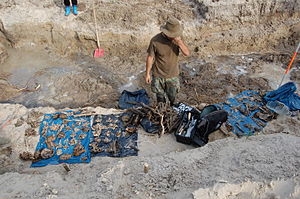- Massacre of Ostrówki
-
Massacre of Ostrówki was a mass murder of Polish inhabitants of a Volhynian village of Ostrówki, located in the interbellum in the gmina of Huszcza, Luboml county, Volhynian Voivodeship of the Second Polish Republic, now known as Ostrowky, located in the Manevychi Raion of the Volyn oblast, Ukraine.
On August 30, 1943, armed members of the Ukrainian Insurgent Army (UIA) murdered 438 Poles. Among the victims there were 246 children under 14 years of age[1]. On the same day, the insurgents murdered 529 Poles in the neighboring village of Wola Ostrowiecka (see Massacre of Wola Ostrowiecka). After the massacre, Ostrówki was burnt to the ground, and all goods were looted by local peasants. In September 1943, commandant of the local UIA unit Lysiy reported to the UIA's headquarters: "I have carried out the operation in the villages of Wola Ostrowiecka and Ostrovky. I have liquidated all Poles, from the youngest to the oldest ones. I burnt all buildings, and appropriated all goods"[2].
The massacre followed a scheme similar to other such events. The village was surrounded by Ukrainians armed with firearms, knives, axes and pitchforks. All Poles were ordered to assemble at a local school, to discuss ways of fighting the Germans. Males were then murdered, followed by women, girls, and then small children. All bodies were then thrown into a pit. Those Poles who remained, were locked in the school, where they either burned alive, or died from grenades[3]. Some time during the massacre, which began at 10 a.m., German soldiers came to investigate the village. Their arrival spurred the murderers to hurry, and a number of women and children were killed in the nearby field. After the Germans had left, the Ukrainians began calling in Polish that the area was clear. Those survivors who responded, were killed[4].
Polish survivors of the massacre and their families organized the first trip to Ostrovky in 1990. They met with inhabitants of the neighboring Ukrainian village of Sokil, but none of the Ukrainians wanted to talk about it. Tomasz Trisiuk, a Polish survivor of the massacre who was 13, remembers that most victims died due to the use of hammers and axes. Another survivor, Helena Popek, who was then 20, stated that the UIA oppressors at first pretended to be friendly, giving out candy to children and telling the Poles to calm down[5].
On August 17, 1992, an exhumation took place in what once was the village of Ostrovky. Altogether, Polish scientists of the Medical Academy from Lublin found 330 bodies, which were reburied on August 30, 1992, on the 49th anniversary of the massacre. All were buried on a local cemetery, and in 2003, a metal cross with a small chapel dedicated to Virgin Mary were erected here[6].
See also
- Historiography of the Massacre of Poles in Volhynia
- Massacres of Poles in Volhynia
References
- ^ Poland's holocaust By Tadeusz Piotrowski page 246
- ^ Władysław Filar, Wolyn 1939-1944, Torun 2003, pages 99-100
- ^ Harvest of despair By Karel Cornelis Berkhoff, page 285
- ^ Harvest of despair By Karel Cornelis Berkhoff, page 286
- ^ Volhynia, 61 years later by Maja Narbutt
- ^ General Consulate of Polish Republic in Lutsk, Ukraine. Polish places of Remembrance in the Lutsk area
External links
Massacres of Polish citizens in World War II Volhynia - Dominopol
- Janowa Dolina
- Kisielin
- Kisorycze
- Kurdybań Warkowicki
- Ostrówki
- Parośla I
- Poryck
- Wola Ostrowiecka
- Żeniówka

Eastern Galicia - Chodaczków Wielki
- Huta Oleska
- Huta Pieniacka
- Korosciatyń
- Lwów
- Palikrowy
- Podkamień
Belarus Lithuania Russia Current Poland  Polish self-defence centres
Polish self-defence centres- Huta Stepańska
- Kuty (in Volhynia)
- Pańska Dolina
- Przebraże
- Stara Huta
Categories:- World War II crimes in Poland
- Poland–Ukraine relations
- 1943 in Europe
- World War II massacres
- History of Poland (1939–1945)
- Massacres in Ukraine
- Massacres of Poles in Volhynia
- Genocides
Wikimedia Foundation. 2010.

